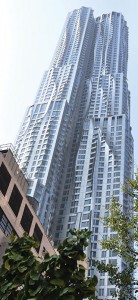WSP Cantor Seinuk was an Award winner for the 8 Spruce Street – Beekman Tower project in the 2012 NCSEA Annual Excellence in Structural Engineering Awards Program (Category – New Buildings over $100M).
When it opened in 2011, the 870-foot, 76-story iconic Beekman Tower, designed by renowned architect Frank Gehry, became New York City’s tallest residential tower. Located just south of the Brooklyn Bridge, the 1.1 million square feet mixed-use building is redefining the skyline of Downtown Manhattan. The tower, offering 903 high-end residential units, luxury amenities and unobstructed 360 degree panoramic views sits above a 100-foot tall, 6-story podium that comprises a new 100,000 square foot public school and a 21,000 square foot ambulatory care center for New York Downtown Hospital.
The building’s main aesthetic is its undulating, asymmetrical steel curtain wall. The sculptural façade is comprised of stainless steel and glass panels and gives the building a sense of movement. Mr. Gehry’s “Bernini folds” conceal a multitude of challenges successfully met through the implementation of innovative structural engineering solutions.
Beekman Tower is a reinforced concrete building. The structure is composed of cast-in-place, concrete flat plate floors supported by reinforced concrete columns and shear walls. The 5- to 6-foot deep mat foundation is supported on 18-inch diameter concrete encased steel piles and also various capacity drilled caissons adjacent to an MTA subway tunnel.
The lateral wind and seismic resisting system is composed of reinforced concrete shear walls surrounding the building’s core. For increased system efficiency, outrigger walls are introduced at mechanical floor levels 6, 38 and 76. The outrigger walls engage the perimeter columns, augmenting the lateral system substantially. These concrete walls were carefully located to minimize the impact of the mechanical equipment functions. The fact that all the shear walls are centralized around the core, with no walls dissecting the typical residential floors, provided the architect/developer great design opportunities unobstructed by the structural elements. The outriggers and their associated belt wall system play a vital role in reducing the building drift as well as the base moments due to lateral forces. These elements helped reduce the thickness of the shear walls and ensured an extremely efficient system. In addition, in order to further provide adequate lateral stiffness and minimize architectural impact, high strength concrete of over 12,000 psi was specified for the shear walls and columns, whereas the specification for slab concrete ranged from 5,000 to 8,600 psi.
The outrigger walls were also used as transfer structures for the exterior columns. The building stacking changes at the outrigger floors, and most of the exterior column pickups are undertaken by the outriggers to maintain efficiency of internal space.
A further unique challenge of axial shortening had to be met. Studies were performed and over-pour values were specified for casting the columns in order to mitigate the effect of differential axial shortening between the core walls and the columns; not just for the final construction condition, but also for the construction sequencing stages.
The structural challenge of accommodating the undulating façade, as well as the differing apartment layouts, was met by ‘walking’ the columns at several locations and levels. No tower floor plates are alike and slab edges are in different planes on every floor; however, in order to simplify the formwork, columns were designed and constructed to stay in the same plane for about every eight to twelve floors. At the ‘change’ levels, the columns broaden or ‘walk’ to encompass the column location above and below. This strategy, apart from avoiding the use of transfer beams, also avoided the need to slope the columns, which would have required more complicated and laborious formwork. The strategy provided the added benefit of maintaining a streamlined construction rhythm. In addition, 3-dimensional CAD detailing was undertaken to design the formwork for the undulating slab edges and maintain the sculptured edge detail of the concrete floors. The process was supplemented by independent x, y, z–coordinate surveying using the Total Station system.
The rectilinear podium is clad in terracotta-colored masonry. Its design was carefully and closely coordinated with the school architects (Swanke Hayden Connell) in order to ensure an optimum layout, considering that the school was supporting the 72 stories above. Larger clear spans of up to 35 feet with 10- to 12-inch flat plate floors were utilized to accommodate the school and hospital architectural layouts compared to the shorter spans using 8-inch flat plate floors within the residential spaces above.
The site is tightly bound on all sides by a hospital, a university, two landmark historic buildings and a subway tunnel. Construction logistics met these challenges by continuously having two concrete trucks available in the building’s west plaza (which was designed to carry their loads) for continuous pouring. The construction team managed to keep to a 2-day cycle at the highest floors by pumping concrete all the way to the top of the building.
Foundation work started in October 2006 and work on the superstructure began in April 2008. The building topped out in November 2009. The project came in under budget and on schedule in spite of a 3 month work hiatus related to the recent recession. The Public School opened in September 2011, and residential leasing and occupancy began in February 2011. The fast-track construction of this unique and iconic building is testament to the overall team’s efficient design and construction planning.▪

